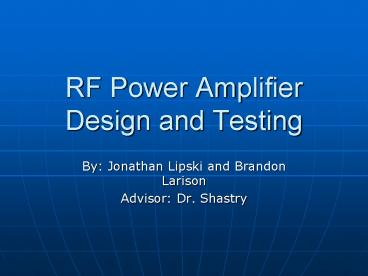RF Power Amplifier Design and Testing PowerPoint PPT Presentation
1 / 46
Title: RF Power Amplifier Design and Testing
1
RF Power Amplifier Design and Testing
- By Jonathan Lipski and Brandon Larison
- Advisor Dr. Shastry
2
Why is this important?
- Wherever there are wireless communications,
there are transmitters, and wherever there are
transmitters, there are RF power amplifiers
-Steve Cripps
3
Presentation Overview
- Project Goals
- Power Amplifier Overview
- Branch-Line Coupler
- ADS Models
- Simulation Results
- Final Results
- Concluding Remarks
- Questions
4
Project Goals
- Building of Power Amplifier Module using
- Commercially Available Power Amplifier Chip
- Power Splitter/Combiner designed from scratch
- WiFi application (2.4-2.5 GHz)
- Output Power 100mW
5
RFMD RF5622 Power Amplifier
- Input/Output Matching
- DC Bias Circuits
6
RF5622 Power Amplifier Layout
7
Power Amplifier Module
8
Power Splitters/Combiners
- Why use them?
- Same gain
- Higher power
- Branch Line vs. Wilkinson
- Extra Resistor Needed
9
Branch Line Coupler Model
10
Branch Line Coupler Theory
11
Calculations
- Widths Lengths
- MSTRIP.exe
- Center Frequency and Characteristic Impedance
- VT-42 Data Sheet (Micro Circuits)
- Height of substrate
- Dielectric Constant
12
First Iteration ADS Model BLC
13
First Iteration ADS Results BLC
14
Port Performance relative to Port 1
15
Return Losses
16
Phase Difference
17
Isolation Losses
18
Tuned ADS Model BLC
19
Tuned ADS Model Results BLC
20
Port Performance relative to Port 1
21
Return Losses
22
Phase Difference
23
Isolation Losses
24
ADS Layout BLC
25
First Iteration ADS Model PA Module
26
First Iteration ADS Results PA Module
27
Port Performance relative to Port 1
28
Return Losses
29
Phase Difference
30
Isolation Losses
31
Tuned ADS Model PA Module
32
Tuned ADS Results PA Module
33
Port Performance relative to Port 1
34
Return Losses
35
Phase Difference
36
Isolation Losses
37
ADS Layout PA Module
38
ADS Layout PA Chip
39
PA Module
40
Testing Procedure
- WiMAX
- Instrumentation cannot handle the power levels
well be using - WiFi
- Requires much less power
41
Testing Procedure
- Network Analyzer
- Measures Return Losses, VSWR,
- S-Parameters
- Spectrum Analyzer
- Measures Output Power
42
Final Results
- Board currently needs to be soldered
- Testing will occur after
- Results and Simulation comparisons will be
documented in final report
43
Concluding Remarks
- Aspects we learned
- Power Amplifier Theory
- Power Divider/Combiner Design
- Microstrip Line Fabrication
44
Concluding Remarks
- Recommendations for Future
- Choose the design first, application second
- Estimate fabrication time, then double it
45
References
- Cripps, Steve C. RF Power Amplifiers for Wireless
Communications. Boston Artech House, 1999.
Print. - Gonzalez, Guillermo. "4.7-4.8." Microwave
Transistor Amplifiers Analysis and Design. Upper
Saddle River, NJ Prentice Hall, 1997. 352-74.
Print. - Grebennikov, Andrei. "Power Amplifier Design
Fundamentals More Notes from the Pages of
History." High Frequency Electronics May 2010
18-30. - "High Power RF Amplifier." RF Power Amplifier
Powerful Amplification. Web. 25 Sept. 2011.
lthttp//www.rfpoweramplifier.org/high_power_rf_amp
lifier.htmlgt. - "RF Power Amplifier." Wikipedia, the Free
Encyclopedia. Web. 25 Sept. 2011.
lthttp//en.wikipedia.org/wiki/RF_power_amplifiergt.
- RFMD, comp. RF5622 Data Sheet. Greensboro, NC
RFMD, 2006. Print.
46
Questions?

